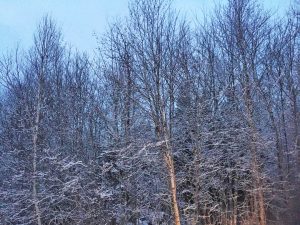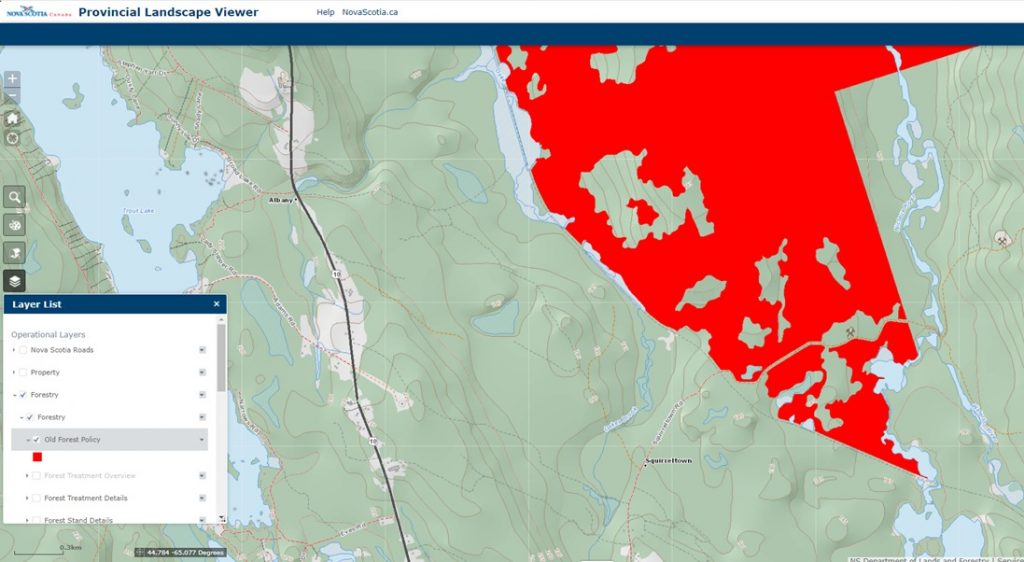
Old Forest Stand on Squirreltown Road “…we can find no sign of ‘old forest’, or ‘old growth’. Instead, there are young, short-lived early successional forests.”
Click on image for larger version
This item was posted today on the Facebook page for the Healthy Forest Coalition
REPORT ON WHAT WAS SEEN AT SQUIRRELTOWN ROAD & RECOMMENDATIONS FOR THE OLD GROWTH FOREST POLICY
Given the achievement of 8 % old growth forests or old growth forest restoration opportunities in NS, as the department of Natural Resources and Renewables (NRR) claims to have attained in the draft Old Growth Forest Policy (up for comment until December 8th), one may wonder just where these stands exist and what they look like.
Strangely the draft policy does not provide us with helpful maps on where the 8 % exists. Setting out to find some in the Old Forest Policy Layer (see instructions below on how to access this), Cloud Lake Wilderness Area is one such place that factors heavily into the 8 % old growth (see Figure 1). Fantastic! We went to have a look at it and took the photo above.
 Figure 1. Old growth in the Cloud Lake Wilderness Area is indicated in red on the “old forest policy” layer in the Provincial Landscape Viewer. |
Taking a drive on the Squirreltown Road, we enter the ‘old forest stands’ indicated on the government website viewer. But we can find no sign of ‘old forest’, or ‘old growth’. Instead, there are young, short-lived early successional forests. It was nearly dark when the “old forest photo” was taken, but you get the picture. The white birch, trembling aspen, and black spruce will likely require at least another century to establish late successional species, if left undisturbed to grow red spruce, yellow birch, and other long-lived species.
WE NEED TO PROTECT OUR REMAINING OLD FORESTS NOW, not leaving them vulnerable to harvesting, since those stands are much more valuable than the stand featured in the photo from Cloud Lake Wilderness Area.
Reality check: We are a very long way from attaining 8 % old growth in Nova Scotia. How far away- no one knows, but it is far from anyone’s hopes and expectations. NRR shuffles the numbers in misleading ways to make us believe they have achieved proper protection of old growth when they have not done so.
The reality is that we are likely fortunate to have even 0.3 % old growth, particularly given the poor management practices of the past decades and the mill consortium who is now in charge of our forests. (Who could ever imagine this was a good idea?)
Government transparency? On reporting forest age classes?
How do we protect more old growth for the future?
• Submit comments to NRR (address and also include the Minister of Natural Resources ( email address)
• Request the government to stop cutting all forests > 100 years old on Crown lands.
• Ask for honest accounting of the amounts of old growth actually present. The draft Old Growth Forest Policy does not even reveal these integral details.
• Insist that more than 25 % old growth be protected to compensate against increased frequencies of disturbances and losses to invasive forest pests that are rapidly spreading and killing forests across NS. To do so, omit from harvesting late succession forests that are 80-100 years to be incorporated as near old growth.
How to view the ‘Old Forest Policy Layer’
1. Open Provincial Landscape Viewer (link) or paste- https://nsgi.novascotia.ca/plv/
2. Click the agreements
3. Go to the far-left side of screen and click on “Layer” button (looks like a tiny stack of paper)
4. There is a list of choices, with arrows on both the LEFT and right side of the word list-
• Unselect “Ecological Land Classification” from the layers list
• Click on the LEFT side of “Forestry” (it will then show another drop down menu)
• Under “Forestry”, select “Forestry” and also under “Forestry”, click “Old Forest Policy” (This will result in red forest polygons on the map.)
• Explore NS for areas that DNRR has declared as “Old Forest”, though most forests are young and stated to be allocated to old forest restoration opportunities.
• To determine what kind of forest exists within a red polygon, select from the Layers list“Forest Stand Details”. (This reveals the species codes and percentages)
5. Optional: To reveal more details, you may choose “basemap gallery” from the top right side of the viewing screen. Select satellite imagery.
